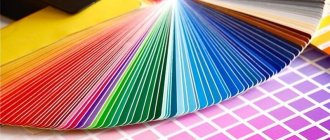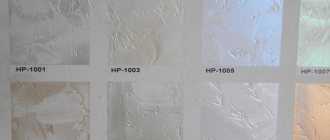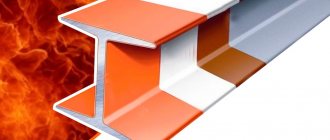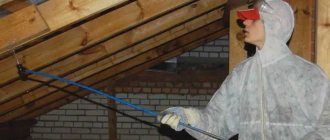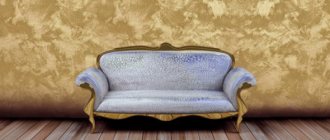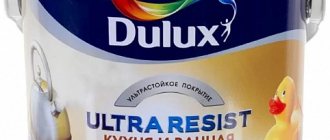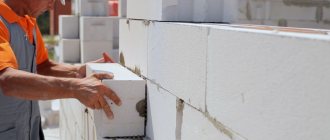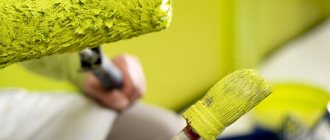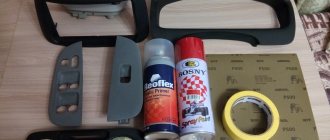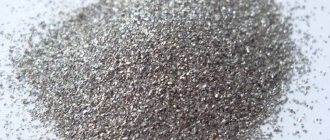Features of latex products
The name of the material comes from latex, which is produced from the juice of rubber plants. This is a natural product obtained from plant materials. There is also its synthetic analogue, which is produced artificially. Thus, latex is not a specific chemical substance, but a specific substance, which is a dispersion of liquid polymers.
Wall with latex paint Source konotop.city
Latex paint is based on the principle of interaction between particles of a substance. The state of the liquid dispersion does not allow the polymers to dissolve in water, while they are constantly in contact with each other. After the composition has been applied to the surface, the liquid begins to gradually evaporate, bringing the particles closer together. After some time, a durable film forms on the wall, which has excellent adhesive and protective properties.
Ceiling paint Source vestnikao.ru
Pros and cons of latex compounds
Latex-based paints have the following advantages:
- Easy application of the material, good adhesion to the surface, the ability to use any method for decoration;
- Durability and strength of the coating, there is no need for frequent updating;
- Environmentally friendly and safe to use. The absence of harmful chemical compounds allows the use of latex paint for interior decoration. The composition is so safe that it can even be used in children's rooms.
- The paint does not smell, so they move into the room immediately after the product has dried.
- The main color of the material is white. To obtain other shades, special pigments are used. As a result, you can achieve any color.
- Economical material consumption. This indicator depends on the basic properties of the surface being treated.
- Low price. Compared to oil paints, latex paint has a significantly more affordable cost and improved characteristics;
- The material dries quickly after application and can be repainted after 6 hours;
- Good breathability. This parameter directly affects the microclimate in the room, since in case of insufficient transmittance, dampness and condensation may form on the walls. This characteristic is especially relevant for wood, which breathes freely even through the applied coating.
- Easy application and low maintenance;
- Moisture-proof and resistant to environmental influences. Thanks to these properties, latex paint can be used to treat external surfaces.
White room Source pro100stroy.com
In addition to the advantages, the material also has disadvantages:
- The surface must be carefully prepared before applying paint. It must be thoroughly cleaned, leveled and ensure a sufficient level of adhesion. Irregularities and imperfections in walls cannot be hidden using a latex composition.
- Latex paint is very sensitive to temperature changes and constant drafts. Exposure to very low temperatures can cause the material layer to crack.
- Since there are no chemicals in the composition, the paint is completely safe for humans. But there is a downside to this property - microbes, fungi and mold also feel comfortable under such material. To prevent their active reproduction, the surface should be pre-treated with special impregnations and antiseptics.
To prepare for applying latex paint, surfaces are primed. It is best to purchase a primer from the same manufacturer as the paint for best results.
Jar of dye Source kraski-trade.ru
What is used to dilute the dye?
Having opened a jar of CM, it is checked for consistency. Most often it is diluted before use. Water is used as a solvent since it is a water-based dye. The resulting paint of the required viscosity remains harmless, has no odor or toxic substances, and dries quickly. The CM is thoroughly mixed and after that water is introduced. Before applying the first coating, 15-20% liquid is added to the composition. For each subsequent coating, 10% water is required. Important: wallpaper is painted with ready-to-use latex paint.
Types of latex paint
Water-based paints containing dispersed particles are generally called latex paints. If you add a certain binding polymer to such a material, you can get a new type of product that has improved properties. There are several known types of latex paints.
Paint for facades Source kraski-kapitel.ru
Polyvinyl acetate paint
One of the most popular products, which is made on the basis of polyvinyl acetate. Among consumers, the popular name “water emulsion” has taken root. This material is unpretentious in application and is affordable, which has led to its high popularity among consumers.
Can of concentrated paint Source dekoriko.ru
Latex paint of this type does not contain organic solvents and does not have a pronounced odor, which makes it safe to use for any room. The product is quickly and easily applied to surfaces and adheres well to them. Before drying, the material is washed off with plain water, so there is always the opportunity to correct the work.
Can of universal paint Source kabel-house.ru
How to choose the right latex paint
Having become familiar with the common types of dyes, you can begin to select the appropriate variety for a specific surface. To do this, it is worth considering the following factors:
- Latex paint is usually suitable for interior or exterior use. There are also universal options that have a higher cost.
- The degree of resistance of a material to wear. If the product is recommended for painting ceilings, it should not be applied to walls to avoid damaging the coating. Typically, such information is indicated on the product packaging.
- Whiteness level. This indicator is relevant for white latex paint. For example, it is advisable to cover the ceiling with a material with a pronounced white tint, and it is recommended to do this in two layers.
- Glossy or matte effect. This parameter affects the final result of the coating. If you want to get a surface with a beautiful shine, then you should opt for gloss. In addition to its attractive appearance, this effect has other advantages. It will successfully hide imperfections in a wall or ceiling, as well as all kinds of irregularities. In the case of matte options, you will need perfectly smooth surfaces, otherwise the slightest flaw will be highlighted and emphasized.
- Covering power. This property is important for those who want to save on the amount of material used.
- Consumption of latex paint per square meter. This parameter also affects savings and is indicated on product packaging.
- Moisture resistant. This quality is especially important for the design of bathrooms and other wet rooms. It is necessary to choose products with the declared properties. Manufacturers often add special additives to it that repel water and make it easy to clean surfaces without consequences.
Paint with a matte effect Source pro100stroy.com
The cost of latex paints depends on the manufacturer and the available characteristics of the composition. A higher price will have to be paid for materials for external work and moisture-resistant options. It should be borne in mind that purchasing an unsuitable product may turn out to be a completely useless waste of money, since the service life of such a coating will be too short.
Painted wall with a clock Source vestnikao.ru
Criteria for choosing varnish material
Latex dye is selected based on its 3 main qualities:
- moisture resistance;
- wear resistance;
- long service life.
The degree of gloss coverage of the surface is taken into account. This indicator is important because gloss is more wear-resistant. But such a coating does not hide base defects. All the irregularities and shortcomings are visible. It is recommended to apply a semi-gloss finish. The matte finish visually masks unevenness, is easy to apply, and washes off dirt well, but its accumulation quickly becomes noticeable. A room painted with matte paint visually becomes smaller and darker.
You need to find out information from the seller about the number of dye abrasion cycles (wet and dry). The wet abrasion indicator is written by the manufacturer on the container.
- for a dry room, a CM with one thousand abrasion cycles is purchased for the ceiling;
- for the walls of a dry room - 1-2 thousand abrasion cycles;
- for a room with humidity - up to 3 thousand abrasion cycles;
- for facades - from 10 thousand abrasion cycles.
The level of abrasion of the coating layer is expressed by the paint class:
- first class – average stability;
- second class - the coating can be wet cleaned without fear;
- third class - the degree of abrasion is low, but the layer is moisture resistant;
- fourth class - used in dry rooms;
- fifth class – resistance to dry and wet abrasion at a low level.
The following brands are in demand on the Russian market:
- Dulux, UK. Ceiling lining – Creations Moonlight; for indoor work, a matte coating is formed - KM Latex Matt; vapor-permeable CM Brilliant White;
- MANDERS, UK . Compositions are available in an assortment of colors. Wood and metal are painted – Intelligent Exterior Eggshell; brick, stone, plaster – Masonry Paint;
- Tikkurilla, Finland. One liter covers an area of 8 m2. For children, Euro 2 is recommended; with increased wear resistance for corridors and kitchens - “Euro 12”; for the external cladding of the house - “Euro Facade Aqua”; with antiseptic – “Luya”; for the ceiling - “Euro Sealing”;
- Caparol, Germany. For indoor work – Samtex 20 ELF; matte coating for ceilings and walls – Aqua-inn N°1, for surfaces with maximum load – SeidenLatex;
- Brands from Poland: Ceresit, Snezka, KABE .
How to paint surfaces with latex paint
To ensure that the coating lasts as long as possible after application, follow simple recommendations for working with latex paints:
- The first step in preparation should be a thorough cleaning of the work area. Loose walls require mandatory strengthening, which is done using a special deep penetration primer. After this, the surface is puttied, thoroughly sanded and dust is removed from it.
- After leveling, surfaces should not be primed with incompatible materials, since in this case there is a risk of applying too much primer, which forms a dense film. As a result, latex paint will lie unevenly, which will lead to serious surface imperfections. To prevent this, you can replace the primer with the same paint diluted with water. This will create both a primer and a first coat of paint.
- It is advisable to apply the material using several tools. A variety of brushes and rollers are best suited for this. The latter are useful for treating large surfaces, while brushes are convenient for painting corners and hard-to-reach places.
- To obtain an even coating, do not interrupt the paint layer. The roller must be carried from floor to ceiling or from wall to wall without stopping.
- Avoid using foam roller attachments, otherwise you may end up with uneven surfaces due to air bubbles.
- Painting must be done quickly to avoid material smudges.
- Before reapplying the composition, you need to wait until the previous layer has completely dried.
Red wall in the living room Source roomester.ru
Stages of work
Painting a surface with latex paints is a process that is almost no different from painting with other solutions.
The following stages of work are distinguished:
- The surface needs major cleaning. All remnants of the old coating must be removed, and if significant defects form, they will need to be eliminated.
Depending on the expected result, the paint can be applied in several layers. The time between approaches depends on the drying time of the treated surface.
In case of paint contamination, it can be removed using either a solvent or a soap solution in the shortest possible time.
Applying this solution to the surface is not a very complicated process; you can handle it yourself . To achieve a positive result, experts strongly recommend adhering to the established sequence.
A roller, a brush, or a spray bottle is perfect as an assistant for this type of work. There is no big difference depending on the type of tool used. The only compelling argument for choice is the ease of working with it. It should also be remembered that the entire surface should be painted in one approach. Otherwise, there may be unevenness along the border of areas that dry out.
Thus, latex paint is a universal finishing material, which is characterized by a wide range of uses, namely for coating walls, ceilings and other surfaces. This mixture will also cope well with the processing of concrete, plaster, brick, wallpaper, drywall, etc. Due to its individual characteristics, this solution is excellent for treating both new coatings and those that have been previously painted.
